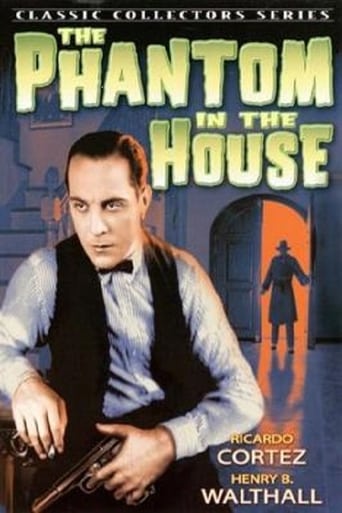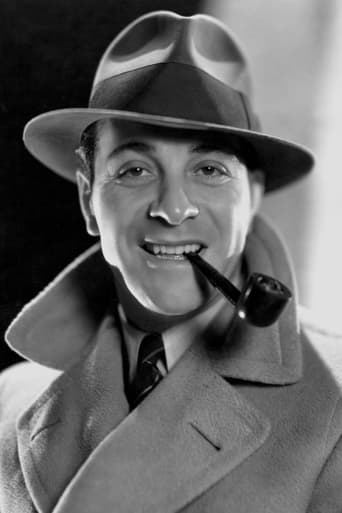The Phantom in the House (1929)
A man is blamed for a murder that was actually committed by his wife.
Watch Trailer
Cast


Reviews
The Age of Commercialism
It's not great by any means, but it's a pretty good movie that didn't leave me filled with regret for investing time in it.
It's an amazing and heartbreaking story.
A movie that not only functions as a solid scarefest but a razor-sharp satire.
The Phantom in the House (1929) ** (out of 4)Peggy (Grace Valentine) accidentally kills her lover just as her husband Boyd (Henry B. Walthall) walks in. Boyd agrees to say he did the crime and spends the next fifteen-years in prison. When he's released he meets back up with the wife but both agreed not to tell their now adult daughter Dorothy (Nancy Welford) that he's really daddy. Soon she wanting to marry Paul (Ricardo Cortez) but he's accused of a murder he didn't really commit. This leads Boyd with a decision to make.If you watch enough of these early sound pictures then you'll notice a few things. For starters, there's usually some sort of musical number for no reason. Second, there's usually a lot of boring dialogue that means absolutely nothing to the story. The third thing you'll notice is that there's usually enough plot for ten different movies. All of this can be understood because sound was something new and people wanted to hear it.With that said, those three things usually make these early talkies rather difficult to watch today and there's no question that this here is one of the silliest I've ever seen. The entire plot is just downright crazy and stupid. What makes matters even worse is that the love affair, the murder, the lie and the prison term is all handled in the first seven minutes of the movie. From here we get on to the new stuff with the daughter getting involved with a man her mother doesn't approve of. This here leads to another murder and we're off on a whole new storyline.The best thing about this picture is Walthall who really was a very good actor. He was perfectly capable of handling silent pictures and he made the transition to sound very well. He's very low-key here but he's certainly easy to follow and you can't help but enjoy the performance and the character Cortez gets the top-billing but the picture certainly belongs to Walthall as he's the actual lead. The supporting performances are mixed to say the least with Valentine coming off the worst with her overacting.THE PHANTOM IN THE HOUSE is a pretty routine drama and for the most part it's very boring. The over-the-top nature of the story and the fact that it was an early sound picture help keep it mildly interesting but for the most part it's a dud.
Some rather stilted acting characterizes this melodrama about a man who confessed to a murder his wife did and got life in prison for it. Henry B. Walthall who played a lot of noble and self sacrificing characters on the silent screen and in talkies was at the top of his game in both those categories. The title of the film is a misnomer because there are no ghostly apparitions here, simply Walthall hanging around his family under an alias. But his daughter Nancy Welford bonds with him and can't explain the connection she feels.Walthall was an inventor and his patents were assigned over to his wife Grace Valentine which has made her a most wealthy society dame. She wants a title for Welford to marry and there's some silly English earl played by Rolfe Sedan hanging around probably looking to give some woman his title for her money. That's not what Welford wants, she wants to marry earnest young Ricardo Cortez. But Valentine threatens to ruin him if he marries her.Into this mess walks Walthall back into their lives, given parole after 15 years. He's traveling incognito at first as the daughter has been given a whole different story about a father who died in the late World War. I won't go any farther except that in the end both the women come to a radical reassessment about things. And Walthall once again thinks of others.I doubt we'll ever see a remake of this old fashioned story. The Phantom Of The House was written for a different with different tastes in literature and different ideas about what constitutes a hero. Also it is plain the players were getting used to sound and both Walthall and Cortez did much better work in sound very shortly.It's a real museum piece of a film.
It's not really necessary to keep in mind that this movie was made at the dawn of the sound era. You don't have to keep it in mind because you'll be constantly reminded of it.The actors pause for eons between lines and when they speak the utterances seem to roll on slowly forever. When the wife addresses the husband's back, you can go outside and take a stroll around the block while he slowly turns around and prepares a response."Do you expect me . . . to believe . . . . . . . . . . . . that?"The lines are stilted and overly theatrical, as if drawn from the 1800s, a parody of the silent movie being parodied in "Singin' in the Rain." The acting is outlandishly overdone. "Oh, mother dear," sobs the young girl sobbing on her mother's shoulder. No kidding.The story is a little complicated and not worth explaining in detail. Henry Walthall takes the rap for his wife when she murders a man trying to rape her. He sends her diagrams of his inventions from prison. She patents them and becomes rich. After fifteen years he returns home under a nom de geôle and finds his spouse distant and materialistic, while his little girl is now grown up and cute. Conflict ensues. Some critical scenes have been deleted for one reason or another.The movie isn't without merit. We often use the expression "lockstep." Originally it didn't mean simply complete agreement on an issue. Lockstep was a method of getting a group of prison inmates from place to place, walking so close behind one another that the steps had to be simultaneous. It used to be sometimes used by hoofers on the stage too, where it was called "nesting." There is an interrogation scene in a police station that lacks any subtlety whatever but does use dramatic lighting. And the director shoots a woman making a phone call. When she hangs up, the camera goes out of focus and wobbles in for a close up of the telephone dial. Cut to a similar shot of another telephone later. It's a wonder he could move the camera at all, those blimps being what they were at the time.If it fails as gripping drama, it succeeds as historical curiosity.
When a male friend tries to take advantage of a woman she kills him in order to protect her honor. Her husband rushes her way just as the police arrive and ends up taking the rap for her. 15 years later he returns home, his wife rich with the money from his inventions, and his daughter believing he's dead. As he tries to get his life back complications arise which threaten the lives of his wife and child.Slow melodrama this film suffers from being made in the early early days of sound. Scenes are often static (though not as static as some other films of the period) with the result the movie feels like its moving at a snails pace. The script isn't bad but it feels more like a mannered play than anything thats real. The dialog is either a pronouncement or an attempt at witticism which more often falls flat. The cast is a mixed bag. To be certain stalwarts like Henry Walthall and Ricardo Cortez show every reason why they had long careers, others clearly were hired because they could speak. This is not the sort of thing one really needs to see unless you are in need of sleep.










